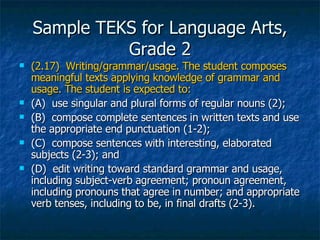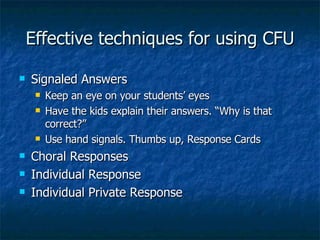Madeline Hunters Lesson Design (Latest)
- 1. Madeline Hunter’s Lesson Design
- 3. Madeline Hunter’s Lesson Design
- 4. “ I’m the decider.” George Bush, 4-18-06
- 5. True, but he’s not the only one… Teachers are always making decisions. In fact teaching can be defined as… “… a constant stream of professional decisions made before, during, and after interaction with the student.” Madeline Hunter
- 6. Researchers have found that… No matter what subject… No matter what age group… ALL TEACHING DECISIONS CAN BE PLACED INTO THREE CATEGORIES…
- 7. Three categories of teaching decisions: What content will I teach next? What will the student do to learn and to demonstrate that learning has occurred? What will I do to make it happen? How will I facilitate the acquisition of that learning?
- 8. The Content Decision TEKS means Texas Essential Knowledge and Skills TEKS are found for everything taught K-12
- 9. To find the TEKS… http://www.tea.state.tx.us/teks/ Or simply Google “Texas TEKS” Click on the subject matter (for middle school and high school) or grade level (for elementary)
- 10. Sample TEKS for 1 st Grade Math (1.1) Number, operation, and quantitative reasoning. The student uses whole numbers to describe and compare quantities. The student is expected to: (A) compare and order whole numbers up to 99 (less than, greater than, or equal to) using sets of concrete objects and pictorial models; (B) create sets of tens and ones using concrete objects to describe, compare, and order whole numbers; (C) identify individual coins by name and value and describe relationships among them; and (D) read and write numbers to 99 to describe sets of concrete objects.
- 11. Sample TEKS for 7th Grade Math (7.1) Number, operation, and quantitative reasoning. The student represents and uses numbers in a variety of equivalent forms. The student is expected to: (A) compare and order integers and positive rational numbers; (B) convert between fractions, decimals, whole numbers, and percents mentally, on paper, or with a calculator; and (C) represent squares and square roots using geometric models.
- 12. Sample TEKS for Language Arts, Grade 2 (2.17) Writing/grammar/usage. The student composes meaningful texts applying knowledge of grammar and usage. The student is expected to: (A) use singular and plural forms of regular nouns (2); (B) compose complete sentences in written texts and use the appropriate end punctuation (1-2); (C) compose sentences with interesting, elaborated subjects (2-3); and (D) edit writing toward standard grammar and usage, including subject-verb agreement; pronoun agreement, including pronouns that agree in number; and appropriate verb tenses, including to be, in final drafts (2-3).
- 13. Sample TEKS for Language Arts, Grade 8 (17) Writing/grammar/usage. The student applies standard grammar and usage to communicate clearly and effectively in writing. The student is expected to: (A) write in complete sentences, varying the types such as compound and complex sentences, and use appropriately punctuated independent and dependent clauses (7-8); (B) use conjunctions to connect ideas meaningfully (4-8); (C) employ standard English usage in writing for audiences, including subject-verb agreement, pronoun referents, and parts of speech (4-8)
- 14. Sample TEKS for Language Arts, Grade 8 (continued) D) use adjectives (comparatives and superlative forms) and adverbs appropriately to make writing vivid or precise (4-8); (E) use prepositional phrases to elaborate written ideas (4-8); (F) use verb tenses appropriately and consistently such as present, past, future, perfect, and progressive (6-8); (G) write with increasing accuracy when using apostrophes in contractions such as doesn't and possessives such as Texas's (4-8); and (H) write with increasing accuracy when using pronoun case such as "She stepped between them and us." (6-8).
- 15. The Content Decision Some TEKS must be taught in order. For other TEKS, the order of acquisition doesn’t matter.
- 16. The Content Decision For TEKS that must be taught in order you need to know whether prior learning has occurred.
- 17. The Content Decision Teachers use both formal and informal quick assessments during teaching to determine the students’ current knowledge and skill levels.
- 18. Planning the Lesson Begin with the curriculum Analyze the task to be accomplished Design the lesson Design the assessment
- 19. Lesson Cycle Steps Anticipatory set (focus) Purpose (objective) Input Modeling (show) Guided Practice (follow me) Checking for Understanding (CFU) Independent Practice Teach your partner Closure
- 20. Anticipatory Set (Focus) A short activity or prompt that focuses the students’ attention before the actual lesson begins. Used when students enter the room or in a transition. Also called “Catch a Sense.” Make it thought provoking, interesting, fun, or exciting!!!
- 21. Anticipatory Set/”Catch a Sense” Examples: Sing “Yankee Doodle” before introducing the Revolutionary War. Bring a flower and have the kids feel and smell it before talking about the parts of a flower. Show an Internet video on lightning before beginning a lesson on weather. Taste a pineapple before having a lesson on Hawaii.
- 22. Setting Objective and Purpose Students will generally spend more time and effort, and consequently increase their learning if they know at the beginning of the lesson what they are going to learn and why it is important to them.
- 23. Examples of Setting Objective and Purpose “Writers use different techniques to hook their readers. Today you will learn three of these techniques so people will want to read what you write.” “Today we’re going to learn how to quickly do percentages in our head so the next time you go to a restaurant you can easily figure the tip.”
- 24. Input The vocabulary, skills and concepts students need to know in order to be successful
- 25. Modeling (Show) Teacher shows in graphic form or demonstrates what the finished product looks like.
- 26. Guided Practice (follow me) Teacher leads the students through the steps necessary to perform the skill using the trimodal approach- hear/see/do.
- 27. Checking for Understanding (CFU) Teacher uses a variety of questioning strategies if the students get it and to pace the lesson- move forward/move backwards Correction or Reteach if needed Acceleration if needed
- 28. Common Errors that Teachers Make During CFU Excessive use of “OK” Asking questions that assume your students understand Asking students if they have any questions Asking questions to kids when you see they are not paying attention
- 29. Effective techniques for using CFU Signaled Answers Keep an eye on your students’ eyes Have the kids explain their answers. “Why is that correct?” Use hand signals. Thumbs up, Response Cards Choral Responses Individual Response Individual Private Response
- 30. Independent Practice Teacher releases students to practice on their own.
- 31. Teach Your Partner Optimum learning has not taken place until students can self-correct and discriminate error. If a student can process the steps to perform a skill, teach these steps to someone else while recognizing errors, then more cognitive thinking and understanding have taken place.
- 32. Closure A review or wrap-up of the lesson.- “Tell me/show me what you have learned today.”
- 33. Model: 7 th Grade LA Lesson Plan Anticipatory Set: The teacher will wear a boa and tiara while reading Fancy Nancy by O’Connor.
- 34. Model: 7 th Grade LA Lesson Plan Purpose/Objective: The student will use an online thesaurus to find synonyms to clarify meaning and usage. (TEK 7.9C) “You will use an online thesaurus to find synonyms or ‘Fancy Words’ for words that we over use. This will make your writing and conversation much more interesting.”
- 35. Model: 7 th Grade Input: Show students Roget’s Thesaurus and look up the word “good”. Read the list of synonyms to the students. Demonstrate the use of Thesaurus. com to locate synonyms quickly.
- 36. Model: 7 th Grade Model: Have a long sheet of butcher paper and create a chart with two columns. First column titled “Plain Words” and second column titled “Fancy Words”. Using Thesaurus.com the teacher will look up the word “smart”. On the chart write “smart” under “Plain Words” and list several synonyms under “Fancy Words”.
- 37. Model: 7 th Grade Guided Practice: The students will use Thesaurus.com to find synonyms for words that are over used. Observe students as they use the website to monitor their progress. Redirect if needed. They will then add their words to the chart.
- 38. Model: 7 th Grade Checking for Understanding (CFU): Ask students to tell you how they found their list of synonyms. What was their most interesting new word? What were some words they have never heard before? Ask for a sentence using that new word.
- 39. Model: 7 th Grade Independent Practice: The students will keep an on going “Fancy Word” journal. Each week they must enter 5 new words with a list of synonyms found using Thesaurus.com.
- 40. Model: 7 th Grade Closure: “Today we have used a new tool to make our writing and conversation more interesting. What is the name of that new tool? (ask for choral response) How do we use that tool? Did you notice any other uses for Thesaurus.com? Can it be helpful in any other way?
- 41. Vary the way you do things. Change the way you teach. Change your voice and movement around the classroom making the students follow where you’re going. Lesson plans that involve a variety of teaching methods. Use the Internet.
- 42. Lesson Cycle Steps Anticipatory set (focus) Purpose (objective) Input Modeling (show) Guided Practice (follow me) Checking for Understanding (CFU) Independent Practice Teach your partner Closure









































